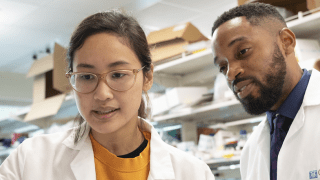Jim Kahan is a retired electrical engineer who still thinks like one.
He can expertly master complex details, a skill that served him well, first with Western Electric and Bell Labs, both part of the then-enormous AT&T and, later, when he pivoted to management, joining SBC — one of the “Baby Bells” — and deftly helping it grow into a new juggernaut through mergers and acquisitions.
By the time he called it a career in 2007, Kahan was already several years into dealing with a chronic blood disorder called polycythemia vera (PV). People with PV produce too many red blood cells, leading to thickening of the blood and often producing dangerous clots and other complications.
Every few months, Kahan would visit his hematologist to have some of that excess blood removed. This worked fine for 20 years. But Kahan began to notice a change.
“My body seemed to get tired of making too many blood cells and started making too few," he said. Instead of having excess blood removed, he began needing blood transfusions.
Kahan’s PV had progressed to an even more serious condition known as post-polycythemia myelofibrosis. Scar tissue was forming in his bone marrow, crowding out healthy cells. This condition can lead to anemia, an enlarged spleen and, sometimes, acute myeloid leukemia.
Extremely Rare Blood Cancer
Kahan’s two ailments are part of a group of blood cancers called myeloproliferative neoplasms (MPN). MPNs are exceedingly rare: Fewer than 300,000 people in the U.S. have them. Equally rare is expertise in the field. A typical oncologist might never see a case of MPN.
Methodically, like an engineer, Kahan went looking for answers, seeking out top MPN experts at major comprehensive cancer centers across the country. City of Hope was not yet on his list. “I’d never heard of City of Hope,” he said.
What he didn’t know at the time was that, not far from Kahan’s Los Angeles home, a shy, young doctor with an unusual background was increasingly getting noticed as an up-and-coming MPN specialist, both on the clinical side and especially as a leading researcher.
Idoroenyi Amanam, M.D., didn’t start out intending to be a physician. A child of immigrants from Nigeria, Amanam was born in the U.S., but when he was 2 months old, the family returned to Africa. Amanam spent most of his first five years in Port Harcourt, Nigeria’s fifth largest city.
Returning to America for elementary school, his classmates teased Amanam for his heavily accented English. “I worked hard to get rid of that accent,” he recalled.
He worked hard at other things, too, building a stellar academic record and winning a Congressional Award for service in high school. “I volunteered at a nursing home, participated in food drives, a soup kitchen, trash clean-up events. I also tutored elementary school kids,” he said.
Called to Oncology
His first plan was to study computer engineering. But a personal tragedy changed his direction.
“When I was in college,” he explained, his voice cracking just a bit, “a close family member died of colon cancer. Her doctors were amazing. How they communicated with us. How they helped us understand. I wanted to be just like them.”
And he wanted to focus on oncology.

“Cancer patients are so humble,” he said. “They didn’t choose their situation. And it’s a humbling experience to take care of them. We don’t understand everything [about cancer], but we do know that having a connection with the patient helps them go through the process.”
After medical school in Tennessee and residency at UCLA, Amanam secured a hematology/oncology fellowship at City of Hope in 2016. He’s been here ever since, impressing, among others, his supervisor/mentor/lab partner and friend, Guido Marcucci, M.D.
“He is a rising star,” said Marcucci, chief of the Division of Leukemia and professor and chair of the Department of Hematologic Malignancies Translational Science. “He is a physician-scientist who can connect the dots, combine the clinical with the lab results. Yes, he was a little bit shy, but once he got comfortable here, we got to see how great he is.
“He reminds me of myself when I started.”
It was the relative obscurity of MPNs that attracted and challenged Amanam.
“MPN is a disease that’s been overlooked,” he explained. “But we’re beginning to understand a little more, identify some targets and develop new treatments.” He’s excited about the prospects for progress in the next 20 years.
His excitement, and his abilities, are getting noticed. Amanam recently received a Junior Investigator Award from the MPN Research Foundation to fund his project examining interleukin-1 receptor accessory protein, or IL-1RAP, as a possible weapon against MPNs. He is also the recipient of the K12 Award by the National Institutes of Health (NIH), which is given, according to the NIH website, “to support institutional career development awards designed to prepare newly trained clinicians who have made a commitment to independent research careers.”
This was the man waiting to meet Kahan and his wife, Diane, when the engineer-turned-businessman finally made his way to City of Hope. The meeting was Marcucci’s idea. He figured that despite the considerable age difference, the two super-achievers would click instantly. Kahan was skeptical. Amanam was intimidated.
“I wondered what I could possibly offer him,” recalled Amanam, “after he’d been to all the biggest experts in the country.”
A Perfect Match
What he offered was exactly what Kahan was looking for.
“We initially spent an hour with him,” said Kahan. “You know, some doctors walk in and right away you sense they’re in a hurry. Dr. Amanam is the opposite. He sits down close to you, he wants to know about you, he answers all your questions, and he never controls the conversation. He lets you express your concerns.
“It’s amazing how open he is, how smart he is, and how he’s able to take complex things and bring them down to a context that you understand. He really de-stresses the situation.”
They briefly explored the possibility of enrolling Kahan in a clinical trial, but it was decided that Kahan’s condition had progressed too far for that. His best hope would be a stem cell transplant, replacing his diseased bone marrow with healthy cells from a donor.
“From the first moment we met him, Dr. Amanam impressed both Jim and me,” Diane said. “We left that initial meeting and both said, ‘Wow’ at the same time. He described the transplant process and the risks and benefits in an understandable way, and answered every single question in a manner that was both clear and reassuring. And Jim had a thousand questions.”
All told, Kahan spent a month at City of Hope, prepping for and receiving the transplant (which came from a young woman in Germany). Throughout the process, Amanam continued “de-stressing” Kahan and Diane, visiting almost every night to speak with him, physician-to-engineer, summarizing the significant clinical steps taken that day and laying out what procedures would take place the next.
“I try to get a sense of where a patient is, unfiltered,” said Amanam. “I respond to them based on what they need. Mr. Kahan liked receiving all that daily information. Knowing more relaxed him.”
Other than a minor bout with graft-versus-host disease (“A rash,” said Kahan. “I’m on meds for it”), the transplant went extremely well. Biopsies show that the donated cells have taken root, and Kahan’s hemoglobin count is approaching normal. Any anemia he experienced pretransplant has disappeared. “I think I’m cured!” he said joyfully.
Amanam is delighted, but far from satisfied. He and Marcucci are testing an antibody on MPNs that may one day make transplants unnecessary. Lab tests on mice have been positive. Human trials will come next.
Kahan wants to help. He’s considering numerous steps to support City of Hope and help Amanam’s research going forward.
“I see Dr. Amanam as one of the young leaders in research. He’s participated in all the progress [with MPNs] in the last five years. MPNs were once considered an ‘orphan’ illness with very little research taking place. That has changed.
“I made a great decision” to come to City of Hope, he concludes. “They saved my life.”
